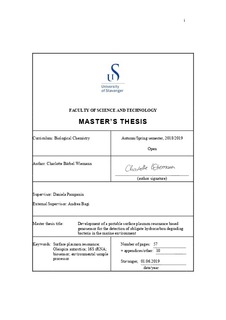| dc.contributor.advisor | Pampanin, Daniela | |
| dc.contributor.author | Wiemann, Charlotte Bärbel | |
| dc.date.accessioned | 2019-10-23T06:22:25Z | |
| dc.date.available | 2019-10-23T06:22:25Z | |
| dc.date.issued | 2019-06-01 | |
| dc.identifier.uri | http://hdl.handle.net/11250/2623807 | |
| dc.description | Master's thesis in Biological chemistry | nb_NO |
| dc.description.abstract | This study aimed at developing a genosensor that could be implemented in the Environmental Sample Processor (ESP) based on surface plasmon resonance (SPR) to detect obligate hydrocarbonoclastic bacteria (OHCB) that can be used as bioindicator species for oil spill events in the marine environment. The final goal was to obtain an SPR assay for the selective and quantitative detection of the OHCB Oleispira antarctica within the context of whole microbial communities, employing a 16S rRNA capture technique for selective enrichment and signal amplification. A custom-made portable SPR instrument was used to develop the assay. The 16S rRNA from O. antarctica was extracted and different hybridization protocols and buffers were tested to selectively enrich the target 16S rRNA out of a pool of RNA. Only one procedure tested yielded promising results. RNA extraction with ESP buffer has proven to be comparable to commercially available extraction methods. Presence and size of the extracted products were verified with reverse transcriptase polymerase chain reaction (RevT-PCR). The SPR sensors surfaces were coated with morpholinos to specifically detect synthetic oligonucleotide sequences mimicking the 16S rRNA of O. antarctica. The morpholino-based DNA detection was characterized in terms of specificity by comparing mismatch oligo signals in different buffer conditions. The mismatched oligos could be differentiated from perfect match oligos at concentrations of 0.5 nM with all buffers yielding best results in DPBS. The sequential amplification approach has proven to excellently work for 45-nt oligonucleotides at concentrations of 0.5 nM. It was used to further detect longer molecules (i.e. 90 bp cDNA), resulting in very low signal intensities. This study has shown that it is possible to use ESP buffer for the extraction of RNA and to detect 45-nt long oligonucleotides in a concentration of 0.5 nm with the SPR instrument. | nb_NO |
| dc.language.iso | eng | nb_NO |
| dc.publisher | University of Stavanger, Norway | nb_NO |
| dc.relation.ispartofseries | Masteroppgave/UIS-TN-IKBM/2019; | |
| dc.rights | Navngivelse 4.0 Internasjonal | * |
| dc.rights.uri | http://creativecommons.org/licenses/by/4.0/deed.no | * |
| dc.subject | 16S rRNA | nb_NO |
| dc.subject | Oleispira antarctica | nb_NO |
| dc.subject | biosensor | nb_NO |
| dc.subject | biokjemi | nb_NO |
| dc.subject | biological chemistry | nb_NO |
| dc.subject | surface plasmon resonance | nb_NO |
| dc.subject | environmental sample processor | nb_NO |
| dc.subject | biologisk kjemi | nb_NO |
| dc.title | Development of a portable surface plasmon resonance based genosensor for the detection of obligate hydrocarbon degrading bacteria in the marine environment | nb_NO |
| dc.type | Master thesis | nb_NO |
| dc.subject.nsi | VDP::Mathematics and natural science: 400::Basic biosciences: 470::Biochemistry: 476 | nb_NO |

